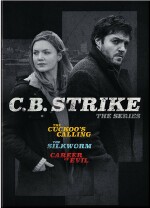Mention the name J.K. Rowling, and the first thing that pops into your head is Harry Potter. She was a struggling writer just getting out of a bad marriage when her first Potter book took the world by storm. Now she’s the wealthiest woman on the planet. The problem has been her life has since been Harry Potter all the time. I can well understand why she might want to find a way to distance future novels from all of that hype and expectation. So she invented Robert Galbraith and wrote a series of detective novels based on a character named C. B. Strike. The novels didn’t come close to the sales of a Potter novel, but they did fairly well, particularly in England. So BBC One and HBO got together for a joint production of the show for both England and the United States. The result is a kind of mini-series that tackles three of the novels in seven hour-long episodes starring Tom Burke as the title character.
The first of the three stories is called The Cuckoo’s Calling and is separated into three hour-long segments. It serves as an introduction to the character. Strike is an ex-military police officer who lost his leg in action. His father was once a huge rock star, but they are estranged. His office/apartment is a small place over a guitar shop where he works alone amid a huge trash heap that looks more appropriate for Hoarders than a detective story. Enter Holliday Grainger as Robin Ellacott. She arrives as a temp that he really can’t afford, but she’s persistent enough to remain and organize his office. He’s not very thrilled to have her, but when a complicated case falls in his lap, he finds her to be indispensible.
A supermodel is thought to have committed suicide; her brother doesn’t believe the story. He is convinced she was murdered and drops money on Strike to investigate the matter. Of course, he’s going against the official finding, and he’s going to run into resistance from the local police, who don’t have a very high opinion of Strike. It’s Robin who uncovers that there was closed-circuit camera footage of two people near her apartment the night she died.
The trouble with this first story is a case of horrible pacing. To say this is a slow burn is an understatement of the worst kind. The show takes too long to get anywhere. There’s a lot of contemplative footage that doesn’t advance the case or get us to know a character any better. It really looks like they were trying very hard to fill space. I have not read any of these novels, but I suspect they are short. It’s obvious that the powers that be involved in creating this show also realized the error of their ways, as the following stories are cut down to just two parts each.
Tom Burke is an interesting performer here. He is relatively stoic. His voice rarely changes in tone, and he doesn’t appear to be much of an emotional guy. I suspect that the character has been beaten down enough times that there’s an overall sense of defeatism in his actions. The episodes themselves are also pretty even-leveled. There isn’t a lot of action or crime-solving, for that matter. These would have made better single-hour episodes.
The second story is called Silkworm. The infamous writer Owen Quine has disappeared, and his wife Leonora (Dolan) has come to Strike to find him. The case goes heavily into the world of writing and publishing that is a world Rowland lives within. It’s hard not to see this as a case of self-indulgence for the writer and contains a bit too much “inside baseball” material. The plot gets quite tangled in methods of writing and who wrote what so that it’s rather mind-numbing before it’s all over. This is easily the weakest of the three stories. Robin once again finds the crucial clue while she’s watching an interview on television.
The final story is also in two parts. It’s called Career of Evil. This is the best and most compelling story of the trilogy. It begins when Robin opens a package delivered to the office. It contains the leg of a woman, and the story is off to a rare fast start. Strike immediately looks at a list of people who might wish to get revenge on him. It’s starting to get a little uncomfortable, as Strike himself becomes a suspect as more body parts come in. He was at the location where the victim was killed, and there’s video evidence that he was there. Someone is not only playing with him, but trying to frame him for the crime. The story also serves as a chance for flashbacks and information that more fully delivers the character’s back story. This one moves at a nice pace and is a fine example of the direction the show should take if there are more to come.
At this point I’m not sure if there are more pending. There aren’t any clues in the short five-minute features for each of these stories. From the marketing of the release, it does not appear that more are planned. I guess we’ll have to wait. “We’ll have to see where it takes us.”



